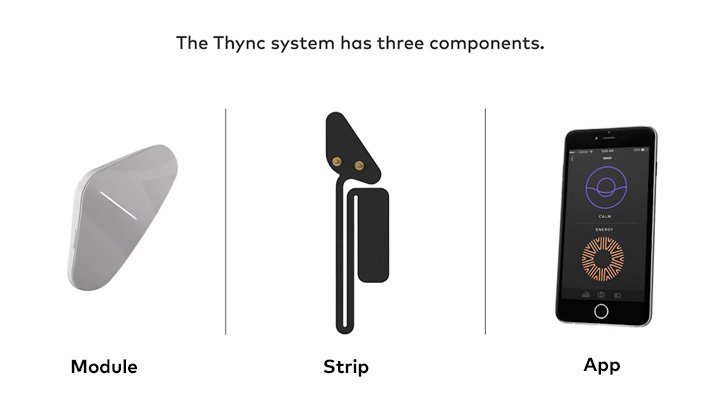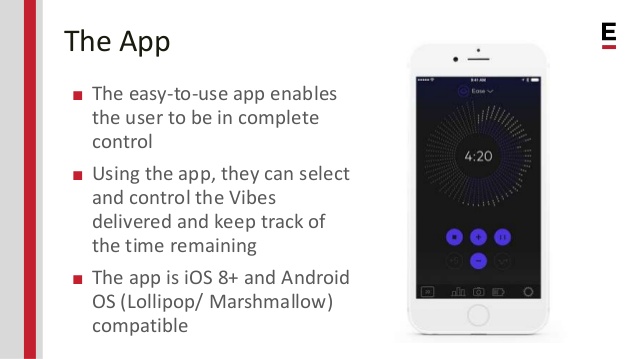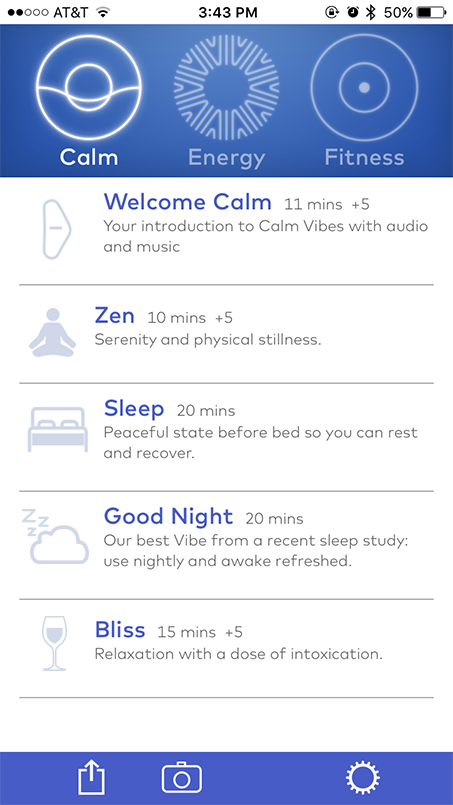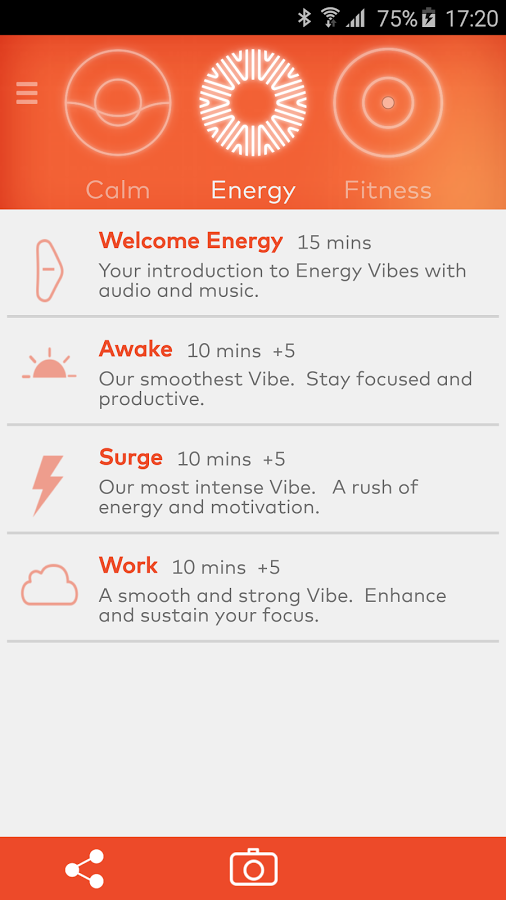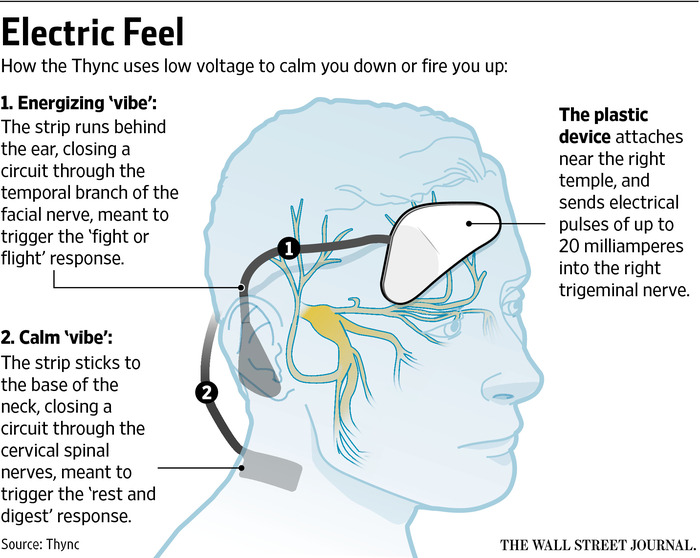Difference between revisions of "Thync"
(Scientific Research-editing) |
(purpose-editing) |
||
| Line 64: | Line 64: | ||
=== Purpose === | === Purpose === | ||
| − | Thync is a wearable device whose main purpose is | + | Thync is a wearable device whose main purpose is improve the mood. Users can choose 2 modes: calm or energy. One session takes 15-20 minutes. |
[[File:Electric_Feel.jpg|thumb|right|alt=Electric Feel|Electric Feel]] | [[File:Electric_Feel.jpg|thumb|right|alt=Electric Feel|Electric Feel]] | ||
Revision as of 16:06, 10 November 2016
| Thync | |
|---|---|
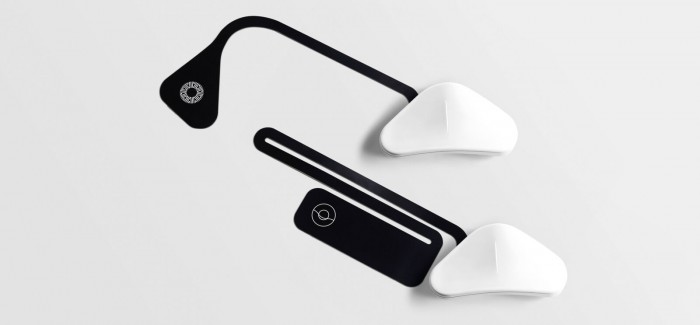
|
|
| Category | Transcranial direct-current stimulation |
| Developer | Thync |
| Announced | October 2014 [1] |
| Released | Developers: October 2014 [1]
Consumers: June 2015 [2] |
| Price | 299 USD [2] |
| Max output | 1010 T 10 mA 0.01 A [3] |
| Session duration | 900900 s 15 minute (900-1200s that is 15-20 min.)[4] |
| Scalp location | Module: right temple of the head, Calm Strip: back of Strip on the center of the back of the neck, Energy Strip: back of Strip on the bone behind your ear (between hairline and ear). [5] |
| Weight | 18 g (Device: 18g, Strips & Liner Card: 6,5g, Charging Cable: 10g)[5] |
| Controls |
smartphone, tablet [5] |
| Data available | good |
| Risk factor | low |
| Medical prescription | no |
| http://www.thync.com/ | |
Thync is a small triangular-shaped head-mounted device that puts on the wearer's head. Headset stimulates and activates nerves, well, the user can either relax or energize. Brain neurons remain intact, the device releases only electrical impulses. In this way, Thync controls user´s mood.[1] Thync is wireless, connected to the smartphone or tablet via Bluetooth (iOS or Android app). Users can control Thync by the official app where they can choose the length of the session. Also, they can adjust the strength of the brain-zapping there (each program follows a pattern of greater and lesser intensity, with cycles of peaks and valleys, but they can also manually raise or lower the overall strength).[6]
Company Thync raised for this project $13.000.000 and started from October 2014.[1]From 02.06.2015 is the device already publicly available and its price is 299$ (7 245,37 CZK to the 22.9.2016).[2]
Contents
Main characteristics
Thync releases the low-level electrical pulses to the nerves in the regions of brain. In this way, change of mood is occurring. The producer describes strictly, how to change the mood is occurring: "Human body balances the activity between sympathetic and parasympathetic nervous systems. The sympathetic system is associated with a "fight or flight" response to help regulate his reaction to stress. The parasympathetic system counteracts stress to help his enter a relaxed "rest and digest" mode".[7]
Thync system has three simple components:
- module - sits on user´s forehead
- strips - placed on the back of user´s neck
- app - controls calm or energy Vibes.[5]
Thync uses neurosignaling to the change of mood. Neurosignaling is on their website defined as follows: "Neurosignaling is the coupling of an energy waveform to a neural structure (receptor, nerve or brain tissue) to modulate its activity. Neurosignaling waveforms or Vibes consist of precise algorithms that bias activity of the sympathetic and parasympathetic nervous systems, so that you can enjoy a shift into a more energetic or relaxed state. Neurosignaling builds upon the best features of long-standing tDCS and TENS techniques by using pulsed currents with lower-intensity and higher-frequency outputs delivered through bio-compatible materials for greater safety and comfort."[7]
Purpose
Thync is a wearable device whose main purpose is improve the mood. Users can choose 2 modes: calm or energy. One session takes 15-20 minutes.
Company & People
The Thync company was founded by Isy Goldwasser and Jamie Tyler in 2011 in Los Gatos, California. Their team is composed of these people:[8]
- Isy Goldwasser - CEO and Founder
- Jamie Tyler Ph.D. - CSO and Founder
- Sumon Pal Ph.D. - Chief of Vibes
- Anil Thakur - CTO
- Jason Egnal - VP, Digital Marketing & Commercial Operations
Important Dates
- 2011 - Co-founding of Company Thync by experts in the fields of neurobiology, neuroscience and consumer electronics from institutions that include MIT, Harvard, and Stanford Universities.
- October 2014 - Beginning of the project Thync.
- June 2015 - start selling the device Thync.[8]
Ethical Issues
Harvard Medical School organized series of conferences "Introduction to Transcranial Direct Current Stimulation in Neuropsychiatric Research" that took place in March 2-3, 2015, June 29-30, 2015 and November 2-3, 2015.[9]On the basis of this, emerged a new title that engaged in neuromodulation and his aspects and that names "Non-Invasive Neuromodulation of the Central Nervous System: Opportunities and Challenges: Workshop Summary." This project was supported by contracts between the many institutions (e.g. National Academy of Sciences and the Alzheimer’s Association, the Department of Health and Human Services’ Food and Drug Administration, National Institutes of Health and others). Among others, participates in the publication the association "The National Academies of Sciences, Engineering, and Medicine". These three Academies works together in order to "provide independent, objective analysis and advise to the nation and conduct other activities to solve complex problem and inform public policy decision." [10]
Many influential people performed in this conference. For example Alvaro Pascual-Leone (professor of neurology at Harvard Medical School) who was the moderator of this conference at the same time criticizes that the neurostimulation is using as off-label application and without examination or a full understanding of safety and efficacy implications. [10] The next, Erik Parens (senior research scholar at The Hastings Center) focused on the non-physical harms. That means, "how a technology might do harm not to our bodies, but to us as human beings."He distinguishes 4 major concerns and defines as follows:[11]
- inauthenticity - "separates us from who we really are or how the world really is"
- complicity - "how these technologies could be used so people can live up to social norms"
- mechanization - "these technologies could make us think of ourselves as machines"
- inequality - "these technologies may exacerbate inequality by providing advantages only to those who have the resources to access the technology"
Parens also criticizes that "the distinction between treatment and enhancement is abstract and fuzzy". It is necessary to define what the treatment is. He informs us that "enhancement has been defined in contrast with treatment" in the 90s of the 20th century. At the moment, treatment should restore normal functioning, despite enhancement should bring something better than normal functioning. Unfortunatelly, there is no bright biological line between normal and better normal functioning, therefore, there is no bright between treatment and enhancement. If there it was, it didn´t follow this line because of ethical issues. Parens thinks that "nobody is against true enhancement, but the people are opposed to things that purport to deliver a benefit but in fact cause harm."[11]
The next who presented in this conference was Martha Farah and Walter H. Annenberg. Both, Martha and Walter, are professors of natural sciences at the University of Pennsylvania. They pointed to 4 overlapping categories of ethical issues (they concern in safety and efficacy):[10]
- safety - impact of long-term use of TMS or tDCS (one session is safe)
- efficacy - "how risky or safe these devices are"
- freedom
- fairness
Roi Cohen Kadosh directed in the conference at the fact that we need further study of the long-term safety of neurostimulation and the impact of neurostimulation on the developing brain. Atul Pande is here worried about the case of low field magnetic stimulation (LFMS) that it can be used at home. An example, somebody used to device longer than the producer states and we don´t know what can happen. Ana Maiques points out that the short-term safety of tDCS is relatively well established but long-term not (and not at all for children or other special populations). Hannah Maslen, postdoctoral research fellow in ethicst at the Oxford Center for Neuroethics, warns us about the fact that many devices was not regulated as medical devices (in Europe or United States) and these are subjected general, non-specific safety requirements. She considers it necessary to approve such devices by FDA (Food and Drug Administration). Jennifer Chandler, professor of law at he University of Ottawa, showed 2 contrasting hypothetical cases, regarding the ethical issues:[10]
- "parents who want their child to undergo non-invasive brain stimulation in order to improve their academic or physical performance
- "criminal offenders who are offered a reduced sentence if the undergo neuromodulation"
From the Januar till June 2014 in Rio de Janeiro, took place the another study regarding ethical issues of brainstimulation that was called "An ethical discussion of the use of transcranial direct current stimulation for cognitive enhancement in healthy individuals: a fictional case study." As emerged from the research, the most important issues are following:
- "(1) whether the modulation of "inner-self" characteristics, such as personality, impulsivity, and social behavior, is acceptable"
- "(2) whether tDCS-induced cognitive enhancement is valid as an adjuvant, fair technique for educational purposes or should be considered "cheating" "
- "(3) the consequences of the widespread use of neuromodulation for those who either cannot afford it or are not willing to receive it"
- "(4) the safety aspects of tDCS"[12]
Such examples (of ethical issues) are many, there are only some of them.
Health Risks
According to the company, there have been no significant issues regarding Thync’s safety profile. It's known that many people engage in alcohol, drugs, and other activities due to stress, anxiety, and mood problems. Thync may allow for a safer way to alleviate these problems.[13]
Thync commented safety of their products like this: "The Thync System is a low-risk transdermal neurostimulation device intended for lifestyle use at home, work, or in wellness applications to temporarily induce mental relaxation or calmness or to temporarily increase energy, awareness, and alertness. The Thync system is a safe and low-risk device. It is not intended to treat or diagnose any disease or medical condition."[7]
As already stated above, the Thync uses TENS and TDCs techniques. "Transcutaneous electrical nerve stimulation(TENS) is a non-invasive analgesic technique that is used to relieve nociceptive, neuropathic, and musculoskeletal pain.[14] Transcranial direct current stimulation (TDCS) is characterized as "the most widely publically-marketed kind of brain stimulation device for cognitive enhancement."”[15]
Risk of these methods is wrong placement of electrodes. Some people are right-handers, but the others are left-handers. Reversing the polarity can be dangerous and can lead to impairment of brain. At the best, it could mean ineffectiveness, in the worst, headache and brain disorders.[15] The manufacter this device recommends that people suffering to Reflex Syncope should be consult their physician before purchasing a Thync System.”[7]
Thync company released on their website "Warnings, Precautions and Adverse Reaction". Some of them are listed below:.[5]
This device can´t be used:
- if someone has a cardiac pacemaker, implanted defibrillator, or other implanted metallic or electronic device.
- during pregnancy or if the woman are breastfeeding.
- if someone has epilepsy or a history of seizures.
- if someone has a Temporomandibular Joint Disorder, Bell’s Palsy, impaired cranial nerve function, or facial pain.
- if someone places Thync Strips on body in locations other than those directed.
- if someone is driving a car, operating machinery, or during any activity in which electrical stimulation can put his at risk for injury.
- in a shower, bath, pool, or other body of water.
- on children under the age of 18.
Enhancement/Therapy/Treatment
In addition to the device changes mood, it could help with sleep problems, reduce stress or the motivation to exercise. Producers also believe that the people could reduce consumption of coffee, alcohol and drugs, as a result of introduction this device.[16]
Public & Media Impact and Presentation
Apart from the fact, that the Thync company has its own website, facebook, twitter and youtube channel, there are the another web portals talking about Thync. One example of this is web portal Quora.com. From example, Yates Buckeley here wrote:
"When released as a product Thync was explained to be a high frequency current stimulation. Research in this area is new so the mechanism (like most brain things) is not well understood."[17]
The most frequently raised points of confusion:[17]
- most people find it relaxing
- some do not / has some side effects
- not well understood
- long term use unclear
- not a medical device
Yates also points out that the recent study found a slight decrease in IQ as a result of basic electrical stimulation and he is afraid of a possible associating with Thync:
"I presume somehow it reset some connections. I have a slight concern Thync could have a similar effect but this is very hard to test."[17]
On the website Digital Trends it is talking about Thync too. Editors have evaluated Thync and it received 7 stars out of 10 stars (very good). They have brought the advantages and disadvantages of Thync together:[18]
Highs
- Relax or energize with a touch of a button
- App is easy to use
- Safe enough to use often
- Feel like you're living in the future
Lows
- High ongoing costs
- Benefits won’t be felt by everyone
- Not very comfortable
Andy Boxall assumed that he felt the effects of Thyncs. But he notes that "there’s a chance it won’t work for others."[18] According to Thync, 80 percent of people will feel the effects. The next disadvantage are the ongoing costs. By them are meant the straps, which should be used only single time. An one pack (5 straps) costs 20$. If someone had used Thync every day, he would spent more than 80$ per month.[18]
John M. Grohol, an psychologist, researcher and expert in mental health, is neutral about Thync. He tried Thync and described that felt an odd sensation but it wasn´t the sensation of calm. He wrote literally: "I didn’t feel an overwhelming sense of calm or euphoria as was suggested I might. But I did feel a sense of… something due to the device. You definitely feel it working. But it would be hard for me — in a single, short sitting — to say what that was."[19]
Natalie Salmanowitz has taken part in a Thync social event at the company’s offices at Runway Incubator. First, she felt the desired energy sensation. She said: "I am not an introvert, but I am also not a small talk enthusiast. Yet, from then on, I was hyper, extroverted, confident and mentally on point. Seems I was vibing."Next day, she tried Thync at home and she felt a pain. About her experience, she speaks as follows: "The next day, I positioned the module the way I had been shown, and tapped start. I felt a familiar feeling, but not the pulsing buzz. Instead, the uncomfortable burning sensation was back. I tried dialling down the intensity and attaching new strips, but the pain persisted."[20]She called by video chat with the support´s team because of positioning process but the burning sensation was persisting. Natalia has visited the Thync´s headquarters in Los Gatos. Thync´s assistant had placed the module on her head but the burning sensation came back. Eventually, Thync´s assistant confused that Natalie "deviated from the norm" and her skin was too sensitive for Thync. The another colleague uttered his speculation: "The vibes depend on your current environment" in other words, may mean the placebo effect.[20]
On the website Amazon.com, you can also find customer reviews. Here Thync gained 3,4 stars out of 5 stars. Some people who bought Thync it evaluated positively, the another negatively. Here are some examples ratings for illustrative purposes:[21]
"It works...but battery life is terrible and support nonexistent so far." (verified purchase, by Seth B on September 15, 2015)
"Wishful thinking but didn't work." (by EvntHrzn on September 12, 2015)
"Really helps me a lot. If you have depression and/or anxiety, give it a try. Company is underselling the benefits." (verified purchase, by Fabio on October 24, 2015)
"No noticeable effects with Thync." (by Alex on August 31, 2015)
"If this works, it's just a placebo effect." (verified purchase, by Eric on September 6, 2015)
"I rate this 10 stars not five. This product has changed my life in such a positive way." (by john m clark on October 7, 2015)
Public Policy
The CES technique (cranial electrotherapy stimulation)has been approved by FDA to treat the depression, anxiety and insomnia. But the tDCS technique which uses the devices like Thync still isn´t approved by FDA. In the Wall Street Journal is literally written: "Thync is exempt from medical-device regulation by the Food and Drug Administration. An FDA spokeswoman declined to comment on the product." Geoffrey A. Fowler, the author of this article, reviewed a letter it sent Thync in which was written that FDA "would consider it a nonmedical “recreational” device as long as it doesn’t change the amount of electrical current it applies, among other factors." [22]
Related Technologies, Project or Scientific Research
Thync has already conducted studies with hundreds participants, and their chief science officer Jamie Tyler is the leading researcher in the neuromodulation (with publications in Nature, PLoS ONE, Neuron, and Brain Stimulation). From the perspective of MedTech Boston, their responses were substantially better than those given by many other neurotech companies touting their wares on the convention floor of CES.[23]
The company Thync published 3 studies that are concerned with their product. The first study was called "The tolerability of transcranial electrical stimulation used across extended periods in a naturalistic context by healthy individuals.". This study was made by PeerJ and examined the safety and tolerability of device. The research involved 100 healthy individuals (63% males and 37% female). It was conducted and observed in the total of 1905 treatment sessions (sham= 636, tDCS= 623, and tPCS= 646) on a total of 100 subjects (sham= 37, tDCS= 33, and tPCS= 30). No severe adverse events were reported. Between or during the sessions, atypical discomfort, headache or migraine or skin condition occurred rarely .[24]
The second study was called "Transdermal neuromodulation of noradrenergic activity suppresses psychophysiological and biochemical stress responses in humans". This study was made by Nature Reports and tested the impact of Neurosignaling on participants. The study consisted of 3 experiments. The first study tested "the influence of TEN on a component of the sympathetic skin response by implementing functional infrared thermography." This experiment was attended by 19 healthy right-handed subjects between the ages of 18 to 27 (7 male, 12 female). The second experiment tested "the impact of TEN on affective mood as reported by the Profile of Mood States (POMS) survey". The second experiment consisted of 45 healthy subjects (16 male, 29 female) that ranged in age from 18 to 43. The third experiment tested "the influence of TEN on psychophysiological arousal and the mobilization salivary biochemicals in response to acute stress induced by a classical fear conditioning
paradigm and a series of time pressured cognitive tasks." The third experiment consisted of 20 male subjects between the ages 19 to 27 (because of hormonal variance in the course of the menstrual cycles). Results of the study are as follows:[25]
- "TEN can significantly dampen basal sympathetic tone compared to sham in a manner sufficient to modulate emotional thermoregulation as reflected in temperature changes of the face."
- "TEN significantly reduced self-reported tension and anxiety compared to sham when subjects are not challenged or presented other environmental stimuli."
- "TEN treatment significantly suppressed sympathetic activity in response to the delivery of unconditioned fear stimuli (electrical shocks) as indicated by the GSC component of the SSR."
- "While TEN can suppress sympathetic activity in response to acute stress, it does so without impeding general/executive cognitive performance."
The third study was called "Transdermal electrical neuromodulation of the trigeminal sensory nuclear complex improves sleep quality and mood". This study was made by bioRxiv and tested sleep quality and mood in healthy subjects (99 individuals). The monitoring took 1 386 days. They observed that: "TEN modulation of trigeminal and cervical nerves prior to sleep onset produced significant improvements in sleep quality and affective states, quantified using clinically validated surveys, overnight actigraph and heart rate recordings, and biochemical analyses compared to baseline or sham controls."[26]
Geoffrey Brookshire and Daniel Casasanto , graduate students in Psychology, University of Chicago, published on 2012 their study that was called "Motivation and Motor Control: Hemispheric Specialization for Approach Motivation Reverses with Handedness". They tested the impact of handedness on tDCS. They recruited 34 right-handers and 12 left-handers. Handedness was determined "using a participant database that allowed us to screen for handedness." Measurements were carried out using electroencephalography (EEG). The starting hypothesis was called "Sword and Shield Hypothesis (SSH)". According to this, the hemispheric laterality of affective motivation depends on the laterality of motor control for the dominant hand (i.e., the "sword hand," used preferentially to perform approach actions) and the nondominant hand (i.e., the "shield hand," used preferentially to perform avoidance actions). This hypothesis was by the research confirmed.[27]
Conclusions are literally following:[27]
"The hemispheric correlates of approach motivation reversed between right- and left-handers, consistent with the way they typically use their dominant and nondominant hands to perform approach and avoidance actions. In both right- and left-handers, approach motivation was lateralized to the same hemisphere that controls the dominant hand. This covariation between neural systems for action and emotion provides initial support for the SSH."
Likewise, Daniel Casasanto spoke openly about this at the annual meeting which took place on the February 11-15, 2016 in Washington, DC. He stated this: "According to new research, righties and lefties think, feel, and act differently, in ways that may influence what we buy, who we find attractive, and even who we vote for. Changing the way people use their hands, even for a few minutes, can change the way they think. Making a rightie act like a leftie can make them think like a leftie. The way we use our hands may also determine how emotions are wired in our brains."[28]
References
- ↑ 1.0 1.1 1.2 1.3 ADHIKARI, Richard. TECHNEWSWORLD. Thync Scores $13M for Foggy Brain Project[online]. Copyright 1998-2016 ECT News Network. [retr. 22.09.2016]. Available online at: http://www.technewsworld.com/story/81165.html
- ↑ 2.0 2.1 2.2 THYNC.COM. Thync Launches First Wearable to Shift Your State of Mind [online]. Copyright 2016 Thync [retr. 22.09.2016]. Available online at: http://www.thync.com/resources/press-release/thync-launches-first-wearable-to-shift-your-state-of-mind
- ↑ PATENTSCOPE. Patent US2013071916-Wearable transdermal electrical stimulation devices and methods of using them[online]. Patentscope, 2014 [retr. 19.10.2016]. Available online at: https://patentscope.wipo.int/search/en/detail.jsf?docId=WO2014082064&recNum=1&maxRec=&office=&prevFilter=&sortOption=&queryString=&tab=PCTDescription
- ↑ THYNC.COM. You Asked, We Answered: Frequently Asked Questions [online]. © Thync 2016 [retr. 18.10.2016]. Available online at: http://www.thync.com/blog/frequently-asked-questions
- ↑ 5.0 5.1 5.2 5.3 5.4 THYNC.COM. Products [online]. Copyright 2016 Thync [retr. 23.09.2016]. Available online at: http://www.thync.com/products
- ↑ GIZMAC.COM. Thync mood-changing wearable officially launches - we go hands on (again) [online]. All content copyright © Gizmag 2003 - 2015 [retr. 16.10.2015]. Available online at: http://www.gizmag.com/thync-hands-on-2/37820/
- ↑ 7.0 7.1 7.2 7.3 THYNC.COM. Science/Technology [online]. Copyright 2015 Thync [retr. 20.10.2015]. Available online at: http://www.thync.com/science-and-technology
- ↑ 8.0 8.1 THYNC.COM. About Us [online]. Copyright 2015 Thync [retr. 16.10.2015]. Available online at: http://www.thync.com/about
- ↑ Harvard Medical School. Introduction to Transcranial Direct Current Stimulation in Neuropsychiatric Research [online]. Beth Israel Deaconess Medical Center, Boston, MA 02215, 2015 [retr. 9.11.2016]. Online available at: http://www.hms-cme.net/106409/
- ↑ 10.0 10.1 10.2 10.3 BAIN, Lisa. NORRIS, Sheena Posey. STROUND, Clare; Rapporteurs. Non-Invasive Neuromodulation of the Central Nervous System: Opportunities and Challenges [online]. United States : Forum on Neuroscience and Nervous System Disorders; Board on Health Sciences Policy; Institute of Medicine; The National Academies of Sciences, Engineering, and Medicine, 2015 (Summary Workshop). [retr. 20.10.2016]. ISBN 978-0-309-37618-1. Available online at: http://www.burke.org/docs/Research_Nina/iom-non-invasive-neuromodulation-ws.PDF
- ↑ 11.0 11.1 PARENS, E. Why IOM Should Consider Broaching ‘Enhancement Concerns’ in the Context of Non-Invasive Brain Stimulation [online]. In Non-invasive Neuromodulation of the Central Nervous System: A Workshop. Washington DC : Institute of Medicine, of the National Academy of Sciences, March 3, 2015. [retr. 9.11.2016]. Available online at: https://www.nationalacademies.org/hmd/~/media/Files/Activity%20Files/Research/NeuroForum/2015-MAR-2/Presentations/Parens.pdf
- ↑ LAPENTA, Olivia M. VALASEK, Claudia A. BRUNONI, André R. BOGGIO, Paulo S. An ethical discussion of the use of transcranial direct current stimulation for cognitive enhancement in healthy individuals: a fictional case study [online]. Psychol. Neurosci. vol.7 no.2 Rio de Janeiro Jan./June 2014. [retr. 24.10.2016]. ISSN 1983-3288. Available online at: http://www.scielo.br/scielo.php?script=sci_arttext&pid=S1983-32882014000200014
- ↑ MEDTECH BOSTON. Testing Thync: A Calming, Energizing Personal Brain Modulator [online]. ©2013-2016 Medical Networking, Inc. [retr. 8.11.2015]. Available online at: https://medtechboston.medstro.com/testing-thync-a-calming-energizing-personal-brain-modulator/
- ↑ JOHNSON, Mark. Transcutaneous electrical nerve stimulation [online]. Oxfords Journals, 2009. [retr. 10.12.2015]. Available online at: http://ceaccp.oxfordjournals.org/content/early/2009/06/26/bjaceaccp.mkp021.full.pdf+html
- ↑ 15.0 15.1 MALEN, Hannah. DOUGLAS, Thomas. KADOSH, Roicohen. LEVY, Neil. SAVULESCU, Julian. Mind Machines. Universtity of Oxford, 2014. [retr. 10.12.2015]. Available online at: http://www.oxfordmartin.ox.ac.uk/downloads/briefings/Mind_Machines.pdf.
- ↑ TECHKRUNCH. Hands-On With Thync's Mood-Altering Headset [online]. © 2013-2015 TechCrunch. [retr. 9.12.2015]. Available online at: http://techcrunch.com/2015/06/02/hands-on-with-thyncs-mood-altering-headset/#.fdgpwg:JNRc
- ↑ 17.0 17.1 17.2 QUORA.COM. What are the potential dangers of brain-zapping devices like Thync? [online]. Quora. com [retr. 8.11.2015]. Available online at: https://www.quora.com/What-are-the-potential-dangers-of-brain-zapping-devices-like-Thync
- ↑ 18.0 18.1 18.2 DIGITAL TRENDS.Thync Review [online]. Digital Trends, 2016 [retr. 19.10.2016]. Available online at: http://www.digitaltrends.com/fitness-apparel-reviews/thync-review/
- ↑ GROHOL, J. What Thync Looks & Feels Like. In Psych Central. Copyright © 1995-2016 Psych Central [retr. 19.10.2016]. Available online at: http://psychcentral.com/blog/archives/2015/06/02/what-thync-looks-feels-like/
- ↑ 20.0 20.1 SALMANOWITZ, Natalie. Thync piece: Do mind-altering wearables live up to the billing? [online]. In New Scientist [publ. 16.4.2016] and [retr. 19.10.2016]. Available online at: https://www.newscientist.com/article/2083126-thync-piece-do-mind-altering-wearables-live-up-to-the-billing/
- ↑ AMAZON.COM. Customer Reviews: Thync Calm and Energy Wearable , Limited Edition [online]. © 1996-2016, Amazon.com, Inc. [retr. 20.10.2016]. Available online at: https://www.amazon.com/Thync-Calm-Energy-Wearable-Limited/product-reviews/B011EVQBG0/ref=cm_cr_arp_d_viewpnt_lft?ie=UTF8&reviewerType=all_reviews&showViewpoints=1&sortBy=helpful&filterByStar=positive&pageNumber=1
- ↑ THE WALL STREET JOURNAL. This Gadget Gives You a Low Voltage-Voltage Pick-Me-Up-WSJ [online]. Copyright ©2016 Dow Jones & Company, Inc. [retr. 18.10.2016]. Available online at: http://www.wsj.com/articles/this-gadget-gives-you-a-low-voltage-pick-me-up-1437503825
- ↑ MEDTECH BOSTON. Testing Thync: A calming, energizing personal brain modulator [online]. MedTech Boston Medical ©2013-2016 [retr. 8.12.2015]. Available online at: https://medtechboston.medstro.com/testing-thync-a-calming-energizing-personal-brain-modulator/
- ↑ PANERI, Bhascar. The tolerability of transcranial electrical stimulation used across extended periods in a naturalistic context by healthy individuals. [online]. New York : The City College of New York, 2015. [retr. 10.12.2015]. Available online at: http://cdn2.hubspot.net/hubfs/432410/documents/peerJ.pdf?t=1447979598033
- ↑ TYLER, William. J. BOASSO, Alyssa M. MORTIMORE, Hailey M. SILVA, Rhonda S. CHARLESWORTH, Jonathan D. MARLIN, Michelle A. AEBERSOLD, Kirsten. AVEN, Linh. WETMORE, Daniel Z. SUMON, K. Pal. Transdermal neuromodulation of noradrenergic activity suppresses psychophysiological and biochemical stress responses in humans [online]. Boston : Scientific reports, 2015. ISSN 2045-2322 [retr. 10.12.2015]. Available online at: http://www.nature.com/articles/srep13865#references
- ↑ BOASSO, Alyssa M. MORTIMORE, Hailey. SILVA, Rhonda. AVEN, Linh. TYLER, William J. Transdermal electrical neuromodulation of the trigeminal sensory nuclear complex improves sleep quality and mood [online]. Boston : Thync, Inc., Boston, MA 02199. [retr. 20.10.2016]. Available online at: http://cdn2.hubspot.net/hubfs/432410/documents/sleep_study.pdf?t=1476966291112
- ↑ 27.0 27.1 BROOKSHIRE, Geoffrey. CASASANTO, Daniel. Motivation and Motor Control: Hemispheric Specialization for Approach Motivation Reverses with Handedness [online]. Published on April 26 2012 in Plos One.© 2012 Brookshire, Casasanto. [retr. 24.10.2016]. Available online at: http://journals.plos.org/plosone/article?id=10.1371/journal.pone.0036036
- ↑ CASASANTO, Daniel. Different Bodies, Different Minds [online]. AAAS 2016 Annual Meeting, Washington DC. [retr. 24.10.2016]. Available online at: https://aaas.confex.com/aaas/2016/webprogram/Paper17430.html
